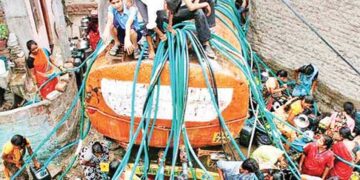Blitz Bureau
NEW DELHI: A NEW survey by Greenpeace India has highlighted the growing water crisis in the national Capital, revealing how low-income families are forced to spend a significant share of their income on buying drinking water.
The study, conducted across 500 households in 12 informal settlements of Delhi, found that nearly one-third of families purchase water from private shops, while others depend on tankers, water ATMs or underground tanks.
According to the survey, 34 per cent of respondents buy water from vendors, 29 per cent rely on government tankers, 21 per cent use water ATMs, and 14 per cent draw from underground sources, while a small section borrow water from neighbours.
Despite these multiple sources, only 28 per cent of households reported receiving adequate water—roughly 20–25 litres per person per day—underscoring a widening gap between demand and supply. The report underlines the heavy financial burden of water insecurity. Families earning between Rs 6,000 and Rs 10,000 a month spend up to 15 per cent of their income, or Rs 500–Rs 1,500, on drinking water alone. Nearly 70 per cent of respondents said rising water prices had forced them to cut down on essentials such as food, healthcare and education.
The situation has a direct impact on livelihoods. About 37 per cent of respondents admitted to missing work or arriving late because they had to spend hours collecting water, adding to the hidden costs borne by women and informal workers in particular.
Promises vs reality
Earlier this year, the Delhi Government announced the installation of 3,000 water ATMs as part of its Heat Action Plan. However, by June only about 20 units were operational, and none in the surveyed areas. Even where installed, residents reported irregular supply, malfunctioning machines, and instances of being charged for water that was meant to be free.
The survey also recorded complaints about tanker services. In several neighbourhoods, tankers arrived only once a week or once in two weeks, often supplying water of poor quality, leaving residents with little choice but to depend on expensive private suppliers. The capital’s water demand stands at 1,250–1,290 million gallons per day (MGD), while supply remains at around 990–1,000 MGD.
Delhi Jal Board (DJB) officials have announced plans to expand capacity with three new treatment plants in Najafgarh, Chhatarpur and Iradat Nagar, expected to add 235 MGD in the coming years.
































